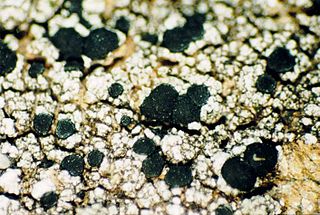
The Lecanoraceae are a family of lichenized fungi in the order Lecanorales. Species of this family have a widespread distribution.

The Letrouitiaceae are a family of lichen-forming fungi belonging to the order Teloschistales. The family, which has a tropical and subtropical distribution, contains the single genus Letrouitia, which contains about 15 species. The family and the genus, both circumscribed in 1982 by André Bellemère and Josef Hafellner, are named in honour of Marie-Agnès Letrouit-Galinou.
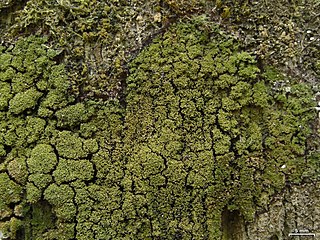
Phyllopsora is a genus of lichen-forming fungi in the family Ramalinaceae. It was circumscribed by Swiss botanist Johannes Müller Argoviensis in 1894, with Phyllopsora breviuscula assigned as the type species.
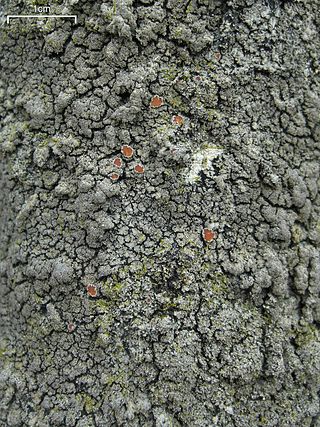
Parmeliella is a genus of lichenized fungi in the family Pannariaceae. It occurs mainly in the tropics and sub-tropics, with species found in Africa, Asia, Australasia and South America. A recent (2020) estimate places 41 species in the genus.
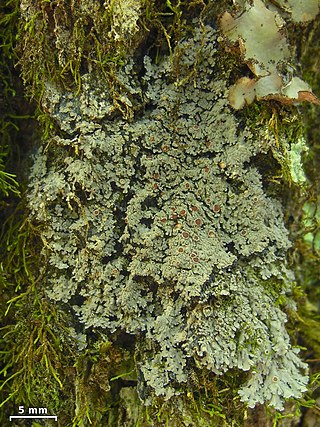
Fuscopannaria is a genus of lichen-forming fungi in the family Pannariaceae. It has 55 species.

Pyxine is a genus of foliose lichens in the family Caliciaceae. The genus has a widespread distribution in tropical regions.
Agonimia is a genus of lichen-forming fungi in the family Verrucariaceae.

Psoroglaena is a genus of lichen-forming fungi in the family Verrucariaceae. The genus was circumscribed by Johann Müller Argoviensis in 1891, with Psoroglaena cubensis assigned as the type species.
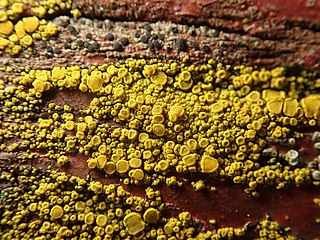
Candelariella is a genus of bright yellow, ocher, or greenish yellow crustose or squamulose lichens in the family Candelariaceae. Members of the genus are commonly called eggyolk lichens, goldspeck lichens, or yolk lichens. The genus was circumscribed in 1894 by Swiss lichenologist Johannes Müller Argoviensis, with Candelariella vitellina assigned as the type species.

Lobothallia is a genus of lichens in the family Megasporaceae. Species in the genus have foliose thalli that become crustose areolate in the center with age, and grow on calcareous to siliceous rocks. The crustose part of the body may keep its lower cortex, though not always. Dark brown to black apothecia may be sunken into the surface of the thallus, as indicated in the common name puffed sunken disk lichen. Members grow to 3–5 cm (1.2–2.0 in) or more radiating lobes (placodioid). The photobiont is green alga from the genus Trebouxia. The genus is represented in Eurasia, Asia, North Africa, Central America, western North America, and Australia.

Squamulea is a genus of lichen-forming fungi in the family Teloschistaceae. It has 15 species. The genus was circumscribed in 2013 by Ulf Arup, Ulrik Søchting, and Patrik Frödén, with Squamulea subsoluta assigned as the type species. Five species were included in the original account of the genus. The genus name alludes to the squamulose growth form of most of its species. Squamulea has a worldwide distribution; when the genus was originally created, the centre of distribution was thought to be in southwestern North America.
Alfred Mycolayovych Oxner was a Ukrainian botanist and lichenologist. His research covered various areas: floristics, taxonomy, phylogenetics, phytogeography, and phytosociology. Oxner founded the National Lichenological Herbarium of Ukraine.
Bryostigma epiphyscium is a species of lichenicolous fungus in the order Arthoniales. Formerly classified in the genera Arthonia and Conida, it was transferred to the genus Bryostigma in 2020.
Bryostigma is a genus of lichen-forming fungi of uncertain familial placement in the order Arthoniales. The genus was circumscribed in 1979 by Josef Poelt and Peter Döbbeler, with the muscicolous lichen Bryostigma leucodontis assigned as the type species. A dozen Arthonia species were transferred into the genus in 2020 following molecular phylogenetic analysis of the family Arthoniaceae that showed distinct phylogenetic lineages that were basal to that family. The genus contains several parasitic species that occur on hosts having chlorococcoid photobionts.
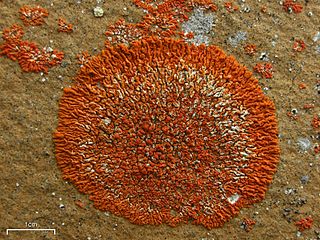
Rusavskia is a genus of lichen-forming fungi in the family Teloschistaceae. It has 12 species. It is a member of the subfamily Xanthorioideae. The thallus of Rusavskia is characterized by its foliose (leaf-like) structure with distinct and typically narrow lobes that curve outwards.
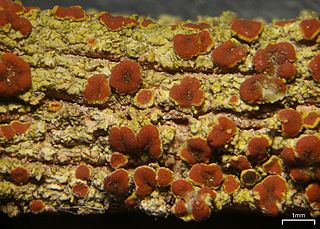
Opeltia is a genus of lichen-forming fungi in the family Teloschistaceae. It has four species of corticolous (bark-dwelling), crustose lichens.
Rusavskia indochinensis is a species of saxicolous (rock-dwelling) lichen in the family Teloschistaceae. It occurs in India and China.
Upretia is a genus of lichen-forming fungi in the family Teloschistaceae. It has three species of saxicolous (rock-dwelling), crustose lichens. Upretia is characterised by its small ascospores and narrow, rod-shaped conidia. The distribution of the genus ranges from mid-altitude rocky terrains in India to both arid and higher altitudinal environments in China.
Oxneriopsis is a genus of lichen-forming fungi in the family Teloschistaceae. It has four species of corticolous (bark-dwelling), crustose lichens.











